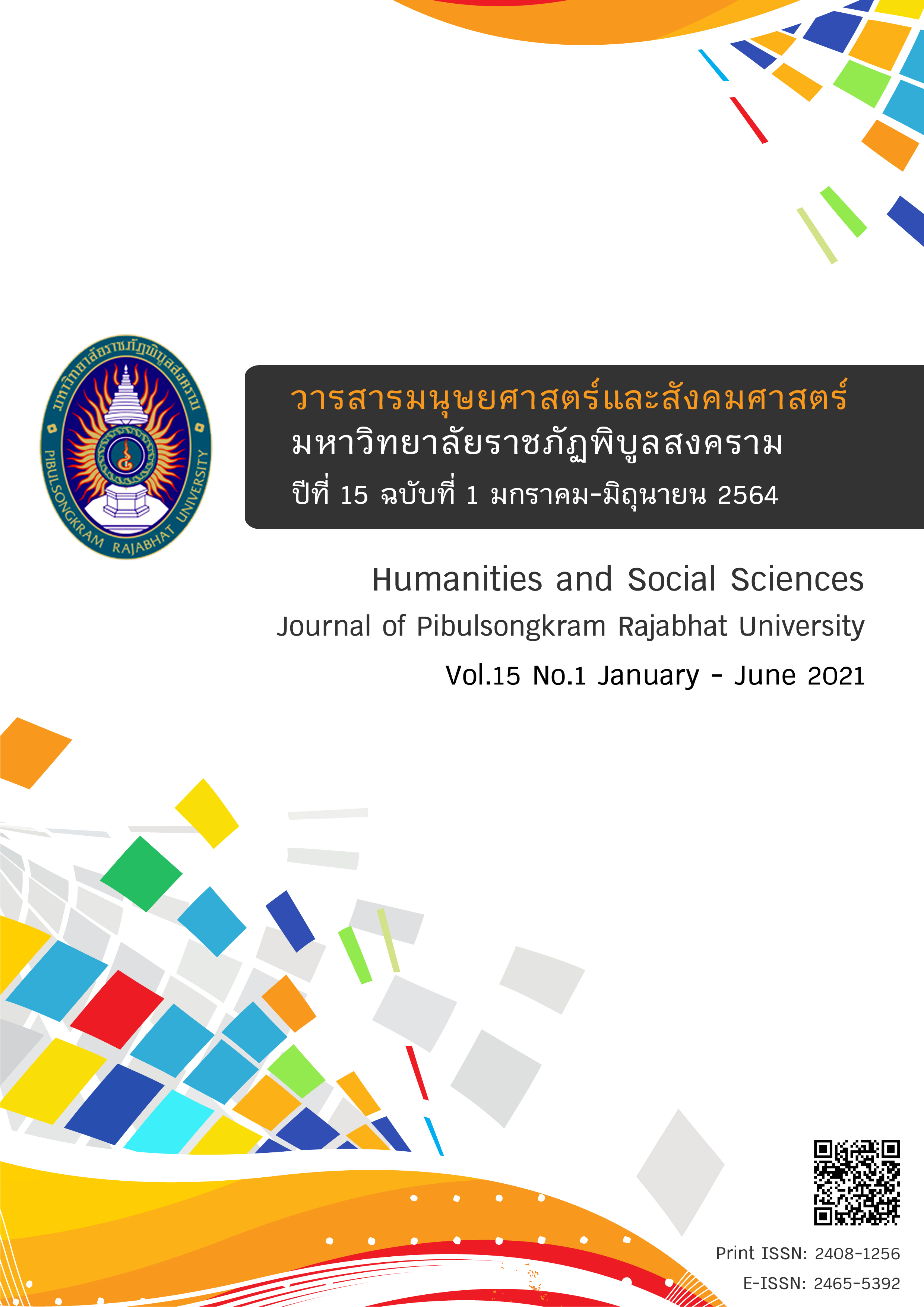Developing reading interpretationt skills in Thai literature of mathayomsuksa 1-6 students with the innovation of plant rhyme in Thai literature
DOI:
https://doi.org/10.14456//psruhss.2021.11Keywords:
Reading interpretationt skills, Plant rhyme in Thai literatureAbstract
This research aimed to 1) develop innovative flora songs in Thai literature to achieve effective goal of 80/80 2) compare the ability to read and interpret the content of literature which has appearance of flora names and 3) study attitude of year 1-6 high school students toward learning flora songs from Thai literature. Samples used in the research consisted of a total number of 32 people of year 1 – 6 high school students. Only one group was used for testing before and after study by research tools including 1) one set of 10 innovative flora songs in Thai literature for different grade levels 2) instructional plan of Thai language learning for literary reading and interpretation using flora songs in Thai literature and 3) ability test quiz (before and after study) of reading and interpreting literary content which contained flora names. The test was composed of multiple choice questions. It was found that 1) the performance of innovative flora songs from Thai literature was equal to 84/87.50 2) the ability to read and interpret of 29 high school students (year 1-6) through innovative “Songs of plants in Thai literature” was greater than 80 percent (90.63%) and 3) the overall attitude of students toward learning with innovative flora songs in Thai literature was in a very good level.
References
กระทรวงศึกษาธิการ. (2551). หลักสูตรแกนกลางการศึกษาขั้นพื้นฐาน พุทธศักราช 2551. กรุงเทพฯ: โรงพิมพ์ชุมนุมสหกรณ์การเกษตรแห่งประเทศไทยจำกัด.
กระแส มาลยาภรณ์. (2532). วรรณคดีเปรียบเทียบเบื้องต้น. กรุงเทพฯ: โรงเรียนสตรีเนติศึกษา แผนกการพิมพ์.
กรรณิการณ์ ฤทธิเดช. (2525). การสร้างหนังสือสำหรับเด็ก. กรุงเทพฯ: วิทยาลัยครูบ้านสมเด็จเจ้าพระยา.
กัลยา ยวนมาลัย. (2539). การอ่านเพื่อชีวิต. กรุงเทพฯ: โอเดียนสโตร์.
กรมวิชาการ. (2546). หนังสือเรียนรายวิชาพื้นฐาน วรรณคดีวิจักษ์กลุ่มสาระการเรียนรู้ภาษาไทยชั้นมัธยมศึกษา ปีที่ 2. กรุงเทพฯ: โรงพิมพ์คุรุสภาลาดพร้าว.
โกชัย สาริกบุตร. (2521). การสร้างความสามารถในการอ่าน. เชียงใหม่: สถาบันราชภัฏเชียงใหม่.
ดวงมน จิตร์จำนงค์. (2541). สุนทรียภาพในภาษาไทย. กรุงเทพฯ: ศยาม.
ประสิทธิ์ เลียวสิริพงศ์. (2530). ความสัมพันธ์ระหว่างภาษากับดนตรี. กรุงเทพฯ: ถนนดนตรี.
พิทยา ลิ้มมณี. (2537). การอ่านตีความ. กรงเทพฯ: โอเดียนสโตร์.
พรรณทิพย์ ต้นเถา. (2539). การเปรียบเทียบกลวิธีการอ่านตีความบทร้อยกรองภาษาไทยของนักเรียน
ชั้นมัธยมศึกษาปีที่ 6 ที่มีความสามารถในการอ่านแตกต่างกัน (วิทยานิพนธ์ครุศาสตรมหาบัณฑิต). จุฬาลงกรณ์มหาวิทยาลัย, กรุงเทพฯ.
พงศกร สมมิตร. (2562). ต้นแบบนวัตกรรม บทเพลงพรรณไม้ในวรรณคดีไทยเพื่อประยุกต์ใช้ในการเรียนการสอนวรรณคดีไทย สำหรับนักเรียนระดับมัธยมศึกษา จังหวัดเชียงราย. ใน การประชุมวิชาการระดับชาติและนานาชาติ ครั้งที่ 3 พ.ศ. 2562 “ความท้าทายของอุดมศึกษาในการผลิตนักศึกษา ระดับบัณฑิตศึกษาในศตวรรษที่ 21”. บุรีรัมย์: มหาวิทยาลัยราชภัฏบุรีรัมย์.
ไพบูลย์ มูลดี. (2546). การพัฒนาแผนการเรียนรู้และแบบฝึกทักษะการเขียนสะกดคำที่ไม่ตรงตามมาตราตัวสะกด (วิทยานิพนธ์การศึกษามหาบัณฑิต). มหาวิทยาลัยมหาสารคาม, มหาสารคาม.
ยุรฉัตร บุญสนิท. (2544). ปัญหาการเรียนการสอนวรรณคดีไทยในยุคปฏิรูปการศึกษา. วารสารภาษาและหนังสือ, 32(3), 56-60.
วรรณภา ไชยวรรณ. (2549). การพัฒนาแผนการอ่านและการเขียนภาษาไทยเรื่องอักษรควบและอักษรนำสำหรับนักเรียนชั้นประถมศึกษาปีที่ 3 โดยใช้แบบฝึกทักษะ (การศึกษาค้นคว้าอิสระการศึกษามหาบัณฑิต). มหาวิทยาลัยมหาสารคาม, มหาสารคาม.
ศรีวิไล ดอกจันทร์. (2529). การสอนวรรณคดีและวรรณกรรมไทย. เชียงใหม่: คณะศึกษาศาสตร์ มหาวิทยาลัยเชียงใหม่.
สุกรี รอดโพธิ์ทอง. (2544). การพัฒนาบทเรียนคอมพิวเตอร์ช่วยสอน : ความรู้เกี่ยวกับสื่อมัลติมีเดียร์เพื่อการศึกษา. กรุงเทพฯ: โรงพิมพ์คุรุสภาลาดพร้าว.
สุจริต เพียรชอบ และสายใจ อินทรัมพรรย์. (2522). วิธีการสอนภาษาไทยระดับมัธยมศึกษา. กรุงเทพฯ: ไทยวัฒนาพานิช.
สุจริต เพียรชอบ. (2540). การพัฒนาการสอนภาษาไทย. กรุงเทพฯ: จุฬาลงกรณ์มหาวิทยาลัย.
สมพร มันตะสูตร แพ่งพิพัฒน์. (2540). การเขียนเพื่อการสื่อสาร. กรุงเทพฯ: โอเดียนสโตร์.
Guilford, J. P. (1956). Fundamental Statistics in Psychology and Education (3rd ed.). New York: McGraw – Hill.
Downloads
Published
How to Cite
Issue
Section
License
Any articles or comments appearing in the Journal of Humanities and Social Sciences, Rajabhat Phibulsongkram University, are the intellectual property of the authors, and do not necessarily reflect the views of the editorial board. Published articles are copyrighted by the Journal of Humanities and Social Sciences, Rajabhat Phibulsongkram University.









